Automatic Detection of Optical Signatures within and around Floating Tonga-Fiji Pumice Rafts Using MODIS, VIIRS, and OLCI Satellite Sensors
Abstract
1. Introduction
2. Data and Methods
2.1. Sentinel-3 Utilization
2.2. Methods for the Automatic Definition of Radiometric Signatures around Pumice Rafts
- (1)
- Chla
- (2)
- Rhos (ρ product at all wavelengths)
- (3)
- Ocean color Rrs reflectance suite
- (4)
- Generalized Inherent Optical Properties suite (GIOP inversion for particle backscattering coefficient, bbp)
- (5)
- Quality control (QC) L2_flags
- (6)
- SST
2.2.1. Infrared Spectrum Usage for Defining Automatically Consolidated Rafts
2.2.2. SeaDAS Masks for Defining Automatically Fragmented Rafts
2.2.3. Ocean Color Thresholds for Automatically Defining Discolored, Mesotrophic, and Normal Oceanic Waters
3. Results
3.1. Temporal Evolution from MODIS and VIIRS
3.2. Temporal Evolution from OLCI and SLSTR, and OLCI Rrs Spectra
4. Discussion
5. Conclusions
Author Contributions
Funding
Institutional Review Board Statement
Informed Consent Statement
Data Availability Statement
Acknowledgments
Conflicts of Interest
References
- Bryan, S.E.; Cook, A.G.; Evans, J.P.; Hebden, K.; Hurrey, L.; Colls, P.; Jell, J.S.; Weatherley, D.; Firn, J. Rapid, long-distance dispersal by pumice rafting. PLoS ONE 2012, 7, e40583. [Google Scholar] [CrossRef]
- Jutzeler, M.; Marsh, R.; Sebille, E.; Mittal, T.; Carey, R.; Fauria, K.; Manga, M.; McPhie, J. Ongoing dispersal of the 7 August 2019 pumice raft from the tonga arc in the Southwestern Pacific Ocean. Geophys. Res. Lett. 2020, 47. [Google Scholar] [CrossRef]
- Hurlbut, G.C.; Verbeek, R.D.M. Krakatau. J. Am. Geogr. Soc. N. Y. 1887, 19, 233–255. [Google Scholar] [CrossRef]
- Sigurdsson, H.; Cashdollar, S.; Sparks, S.R.J. The Eruption of Vesuvius in A. D. 79: Reconstruction from historical and volcanological evidence. Am. J. Archaeol. 1982, 86, 39–51. [Google Scholar] [CrossRef]
- Oppenheimer, C. Climatic, environmental and human consequences of the largest known historic eruption: Tambora volcano (Indonesia) 1815. Progr. Phys. Geogr. 2003, 27, 230–259. [Google Scholar] [CrossRef]
- Jutzeler, M.; Marsh, R.; Carey, R.J.; White, J.D.L.; Talling, P.J.; Karlstrom, L. On the fate of pumice rafts formed during the 2012 Havre submarine eruption. Nat. Commun. 2014, 5, 3660. [Google Scholar] [CrossRef]
- Smithsonian Institute Most Recent Weekly Report: 14 August to 20 August 2019. Available online: https://volcano.si.edu/volcano.cfm?vn=243091 (accessed on 30 November 2020).
- Vaughan, R.; Abrams, M.; Hook, S.; Pieri, D. Satellite Observations of new volcanic island in Tonga. Eos. Trans. Am. Geophys. Union 2007, 88. [Google Scholar] [CrossRef]
- Mantas, V.M.; Pereira, A.J.S.C.; Morais, P.V. Plumes of discolored water of volcanic origin and possible implications for algal communities. The case of the home reef eruption of 2006 (Tonga, Southwest Pacific Ocean). Remote Sens. Environ. 2011, 115, 1341–1352. [Google Scholar] [CrossRef]
- Brandl, P.A.; Schmid, F.; Augustin, N.; Grevemeyer, I.; Arculus, R.J.; Devey, C.W.; Petersen, S.; Stewart, M.; Kopp, H.; Hannington, M.D. The 6–8 August 2019 eruption of ‘Volcano F’ in the Tofua Arc, Tonga. J. Volcanol. Geotherm. Res. 2020, 390, 106695. [Google Scholar] [CrossRef]
- Duggen, S.; Croot, P.; Schacht, U.; Hoffmann, L. Subduction zone volcanic ash can fertilize the surface ocean and stimulate phytoplankton growth: Evidence from biogeochemical experiments and satellite data. Geophys. Res. Lett. 2007, 34, L01612. [Google Scholar] [CrossRef]
- Urai, M.; Machida, S. Discolored seawater detection using ASTER reflectance products: A case study of Satsuma-Iwojima, Japan. Remote Sens. Environ. 2005, 99, 95–104. [Google Scholar] [CrossRef]
- Matangi Tonga Online Aviation Alert as Metis Shoal Smoke Eruption Towers. Available online: https://matangitonga.to/2019/10/15/aviation-alert-metis-shoal-smoke-eruption-towers (accessed on 23 November 2020).
- Blondeau-Patissier, D.; Gower, J.F.R.; Dekker, A.G.; Phinn, S.R.; Brando, V.E. A review of ocean color remote sensing methods and statistical techniques for the detection, mapping and analysis of phytoplankton blooms in coastal and open oceans. Progr. Oceanogr. 2014, 123, 123–144. [Google Scholar] [CrossRef]
- Kahru, M.; Savchuk, O.; Elmgren, R. Satellite measurements of cyanobacterial bloom frequency in the Baltic Sea: Interannual and spatial variability. Mar. Ecol. Progr. Ser. 2007, 343, 15–23. [Google Scholar] [CrossRef]
- Hu, C.; Cannizzaro, J.; Carder, K.; Muller-Karger, F.; Hardy, R. Remote Detection of Trichodesmium blooms in optically complex coastal waters: Examples with MODIS full-spectral data. Remote Sens. Environ. 2010, 114, 2048–2058. [Google Scholar] [CrossRef]
- Gower, J.K. Young global remote sensing of Trichodesmium. Int. J. Remote Sens. 2014, 35. [Google Scholar] [CrossRef]
- Mckinna, L. Three decades of ocean-color remote-sensing Trichodesmium Spp. in the world’s oceans: A review. Progr. Oceanogr. 2014, 131, 177–199. [Google Scholar] [CrossRef]
- Rousset, G.; De Boissieu, F.; Menkes, C.; Lefèvre, J.; Frouin, R.; Rodier, M.; Ridoux, V.; Laran, S.; Bonnet, S.; Dupouy, C. Remote sensing of Trichodesmium Spp. mats in the western tropical South Pacific. Biogeosciences 2018, 15, 5203–5219. [Google Scholar] [CrossRef]
- Hu, C.; Feng, L.; Hardy, R.; Hochberg, E. Spectral and spatial requirements of remote measurements of Pelagic Sargassum macroalgae. Remote Sens. Environ. 2015, 167. [Google Scholar] [CrossRef]
- Ody, A.; Thibaut, T.; Berline, L.; Changeux, T.; André, J.-M.; Chevalier, C.; Blanfuné, A.; Blanchot, J.; Ruitton, S.; Stiger-Pouvreau, V.; et al. From in situ to satellite observations of Pelagic Sargassum distribution and aggregation in the tropical North Atlantic Ocean. PLoS ONE 2019, 14. [Google Scholar] [CrossRef]
- Dupouy, C.; Frouin, R.; Tedetti, M.; Maillard, M.; Rodier, M.; Fabien, L.; Guidi, L.; Picheral, M.; Duhamel, S.; Charrière, B.; et al. Diazotrophic Trichodesmium influence on ocean color and pigment composition in the South West Tropical Pacific. Biogeosci. Discuss. 2018, 1–43. [Google Scholar] [CrossRef]
- EUMETSAT Sentinel-3A Product Notice–OLCI Level-2 Ocean Colour; EUMETSAT: Darmstadt, Germany, 2019.
- Hu, C.; Lee, Z.; Franz, B. Chlorophyll a Algorithms for Oligotrophic Oceans: A novel approach based on three-band reflectance difference. J. Geophys. Res. 2012, 117, C01011. [Google Scholar] [CrossRef]
- The Guardian Massive Pumice “raft” Spotted in the Pacific Could Help Replenish Great Barrier Reef. The Guardian. 25 August 2019. Available online: https://www.theguardian.com/environment/2019/aug/25/massive-pumice-raft-spotted-in-the-pacific-could-help-replenish-great-barrier-reef (accessed on 31 January 2021).
- Chand, S. Pumice Menace Hits Parts of Lau Group. Available online: https://fijisun.com.fj/2019/09/12/pumice-menace-hits-parts-of-lau-group/ (accessed on 26 August 2020).
- Leblanc, K.; Cornet, V.; Rimmelin-Maury, P.; Grosso, O.; Hélias-Nunige, S.; Brunet, C.; Claustre, H.; Ras, J.; Leblond, N.; Quéguiner, B. Silicon CYCLE IN THE TROpical South Pacific: Contribution to the global si cycle and evidence for an active pico-sized siliceous plankton. Biogeosciences 2018, 15, 5595–5620. [Google Scholar] [CrossRef]
- Guieu, C.; Bonnet, S.; Anne, P.; Menkes, C.; Chavagnac, V.; Desboeufs, K.; Maes, C.; Moutin, T. Iron from a submarine source impacts the productive layer of the Western Tropical South Pacific (WTSP). Sci. Rep. 2018, 8. [Google Scholar] [CrossRef] [PubMed]
- Dupouy, C.; Frouin, R.; Tedetti, M.; Maillard, M.; Rodier, M.; Lombard, F.; Guidi, L.; Picheral, M.; Neveux, J.; Duhamel, S.; et al. Diazotrophic Trichodesmium impact on UV–Vis radiance and pigment composition in the Western Tropical South Pacific. Biogeosciences 2018, 15, 5249–5269. [Google Scholar] [CrossRef]
- Moutin, T.B.B.; Beker, B.; Dupouy, C.; Rimmelin, P.; Bouteiller, A. Phosphate availability controls Trichodesmium Spp. biomass in the SW Pacific Ocean. Mar. Ecol. Prog. Ser. 2005, 297, 15–21. [Google Scholar] [CrossRef]
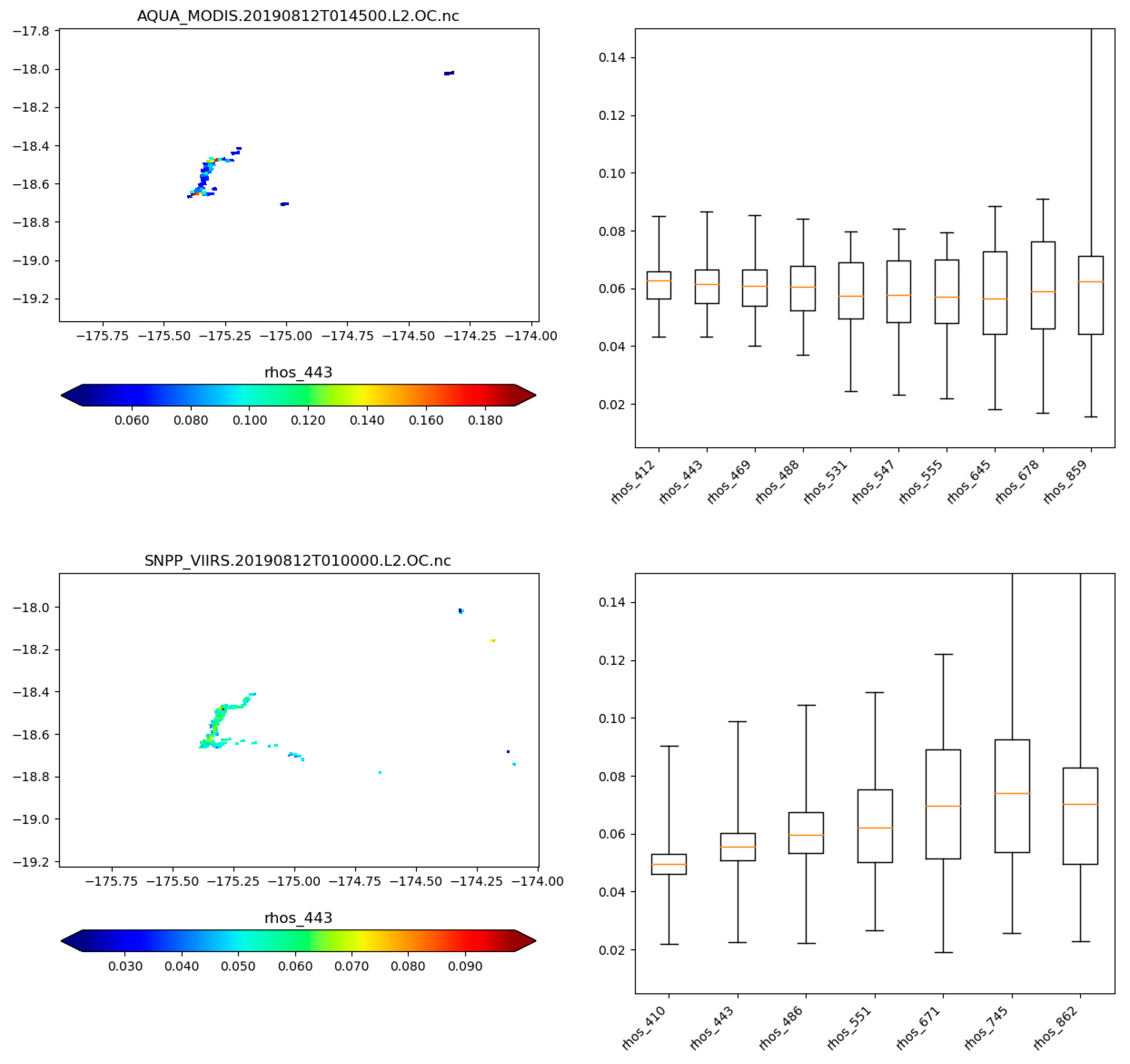

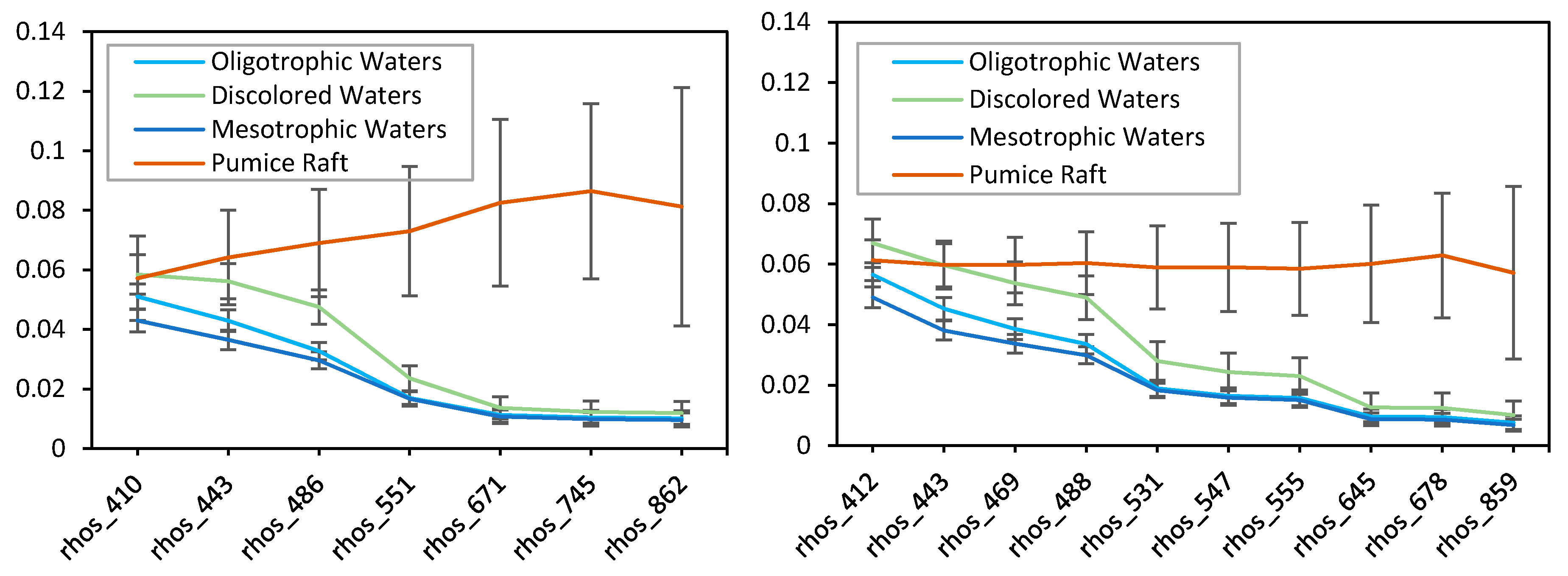
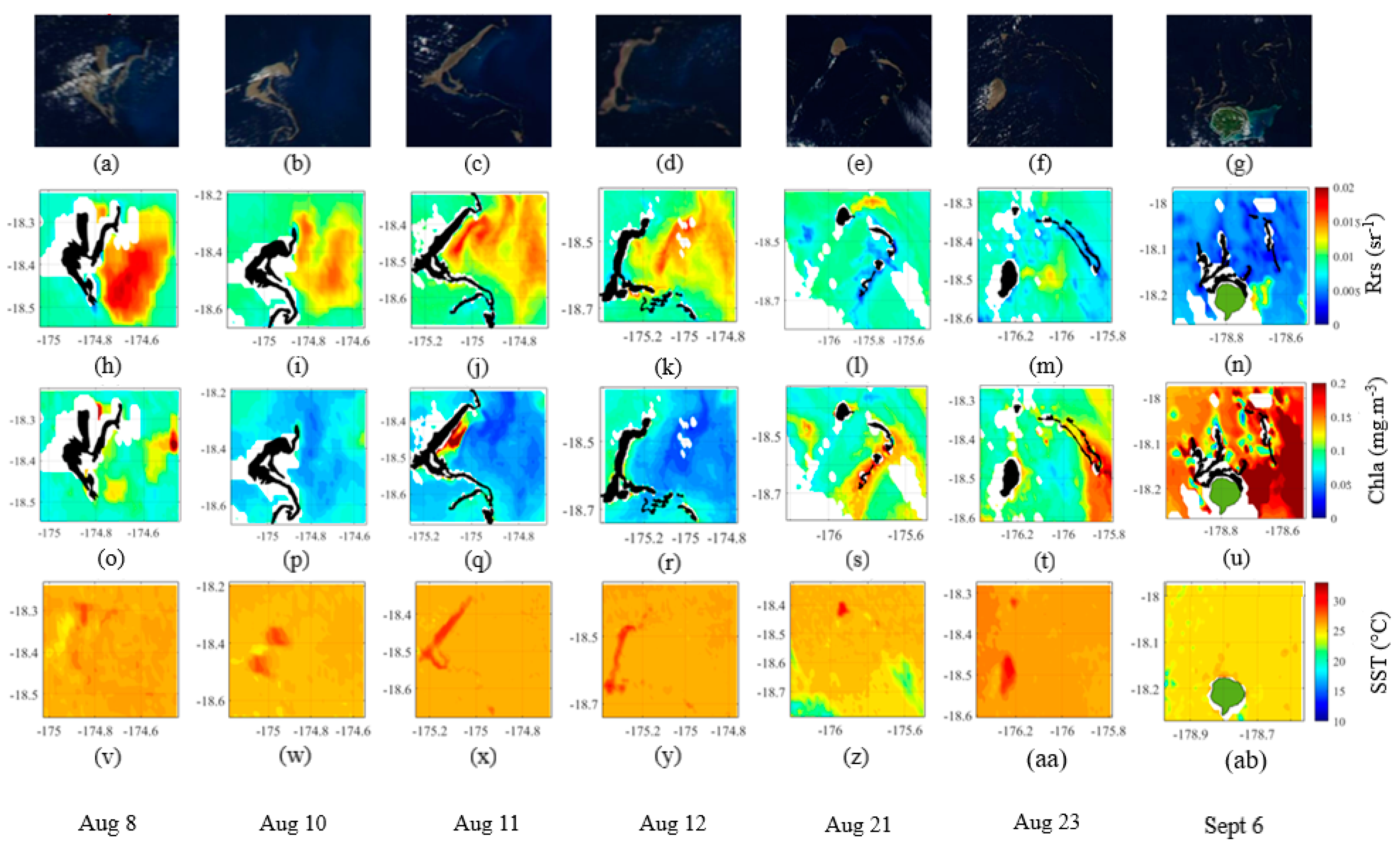
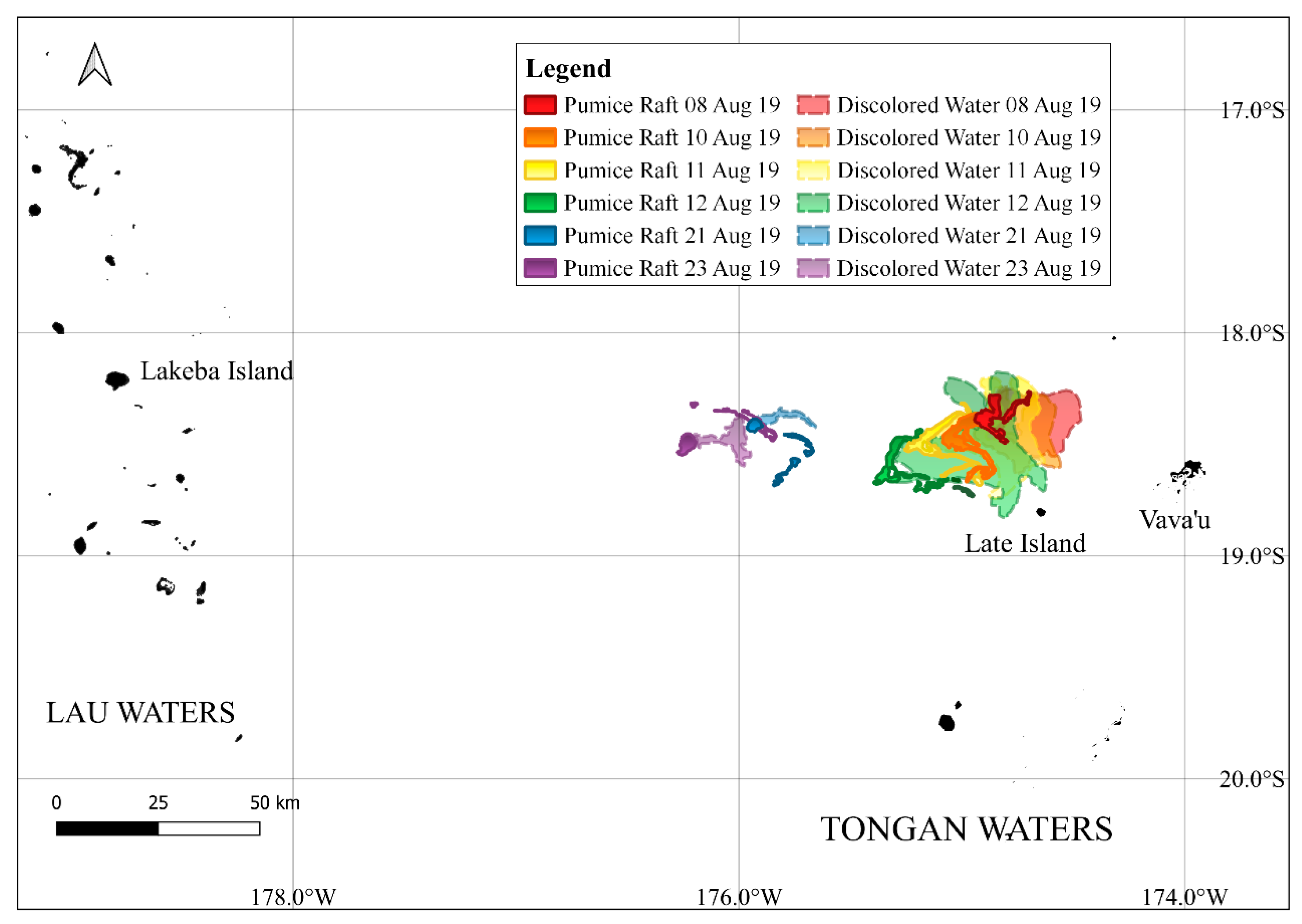
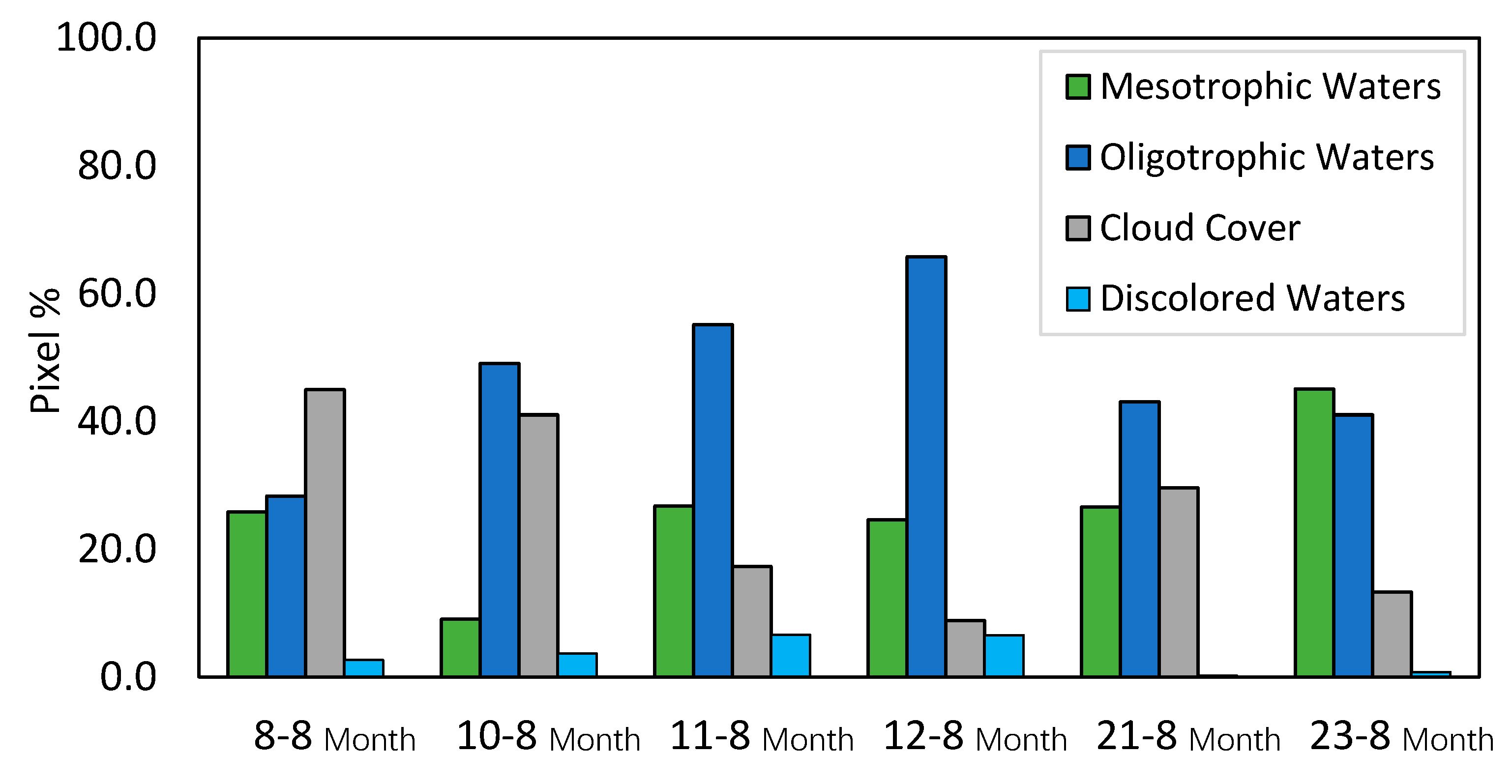
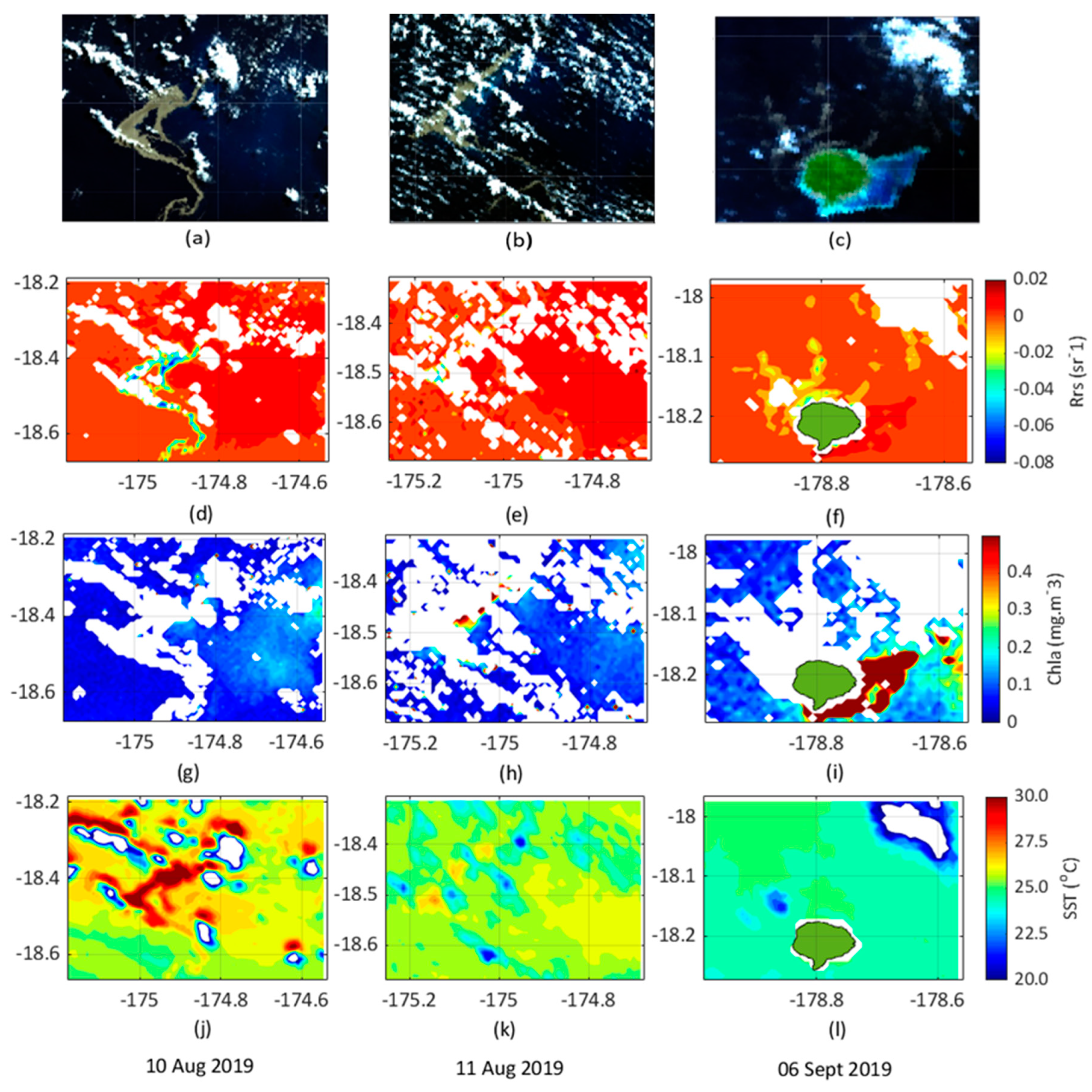

| DATE (UTC) | SENSOR | TILE ID (Chla and Rrs) | TILE ID (SST) | ACQUISITION PERIOD (UTC) | N LAT. | S LAT. | W LON. | E LON. |
|---|---|---|---|---|---|---|---|---|
| 8 August 19 | MODIS Terra | T2019220223000 | TERRA_MODIS.20190808T223001.L2.SST | 22:30–21:34 | –18.231 | –18.565 | –175.032 | –174.433 |
| 9 August 19 | OLCI, SLSTR Sentinel-3A | S3A_OL_2_WFR____20190809T213305_20190809T213605_20190809T233806_0179_048_043_3240_MAR_O_NR_002 | S3A_SL_2_WST____20190809T213305_20190809T213605_20190809T233506_0179_048_043_3240_MAR_O_NR_003 | 21:33–21:36 | –18.189 | –18.678 | –175.176 | –174.530 |
| 10 August 19 | MODIS Aqua | A2019222015500 | AQUA_MODIS.20190809T213501.L2.SST | 01:55–02:00 | –18.189 | –18.678 | –175.176 | –174.530 |
| OLCI, SLSTR Sentinel-3A | S3A_OL_2_WFR____20190810T210654_20190810T210954_20190810T231200_0179_048_057_3240_MAR_O_NR_002 | S3A_SL_2_WST____20190810T210654_20190810T210954_20190810T231059_0179_048_057_3240_MAR_O_NR_003 | 21:06–21:09 | –18.312 | –18.682 | –175.256 | –174.672 | |
| 11 August 19 | VIIRS | V2019223011800 | SNPP_VIIRS.20190811T011800.L2.SST | 01:18–01:23 | –18.312 | –18.682 | –175.256 | –174.672 |
| 12 August 19 | VIIRS | V2019224010000 | SNPP_VIIRS.20190812T010000.L2.SST | 01:00–01:05 | –18.338 | –18.746 | –175.388 | –174.749 |
| 21 August 19 | MODIS Aqua | A2019233014000 | AQUA_MODIS.20190821T014001.L2.SST | 01:40–01:44 | –18.324 | –18.802 | –176.216 | –175.483 |
| 23 August 19 | MODIS Aqua | A2019235012500 | AQUA_MODIS.20190823T012501.L2.SST | 01:25–01:30 | –18.271 | –18.621 | –176.365 | –175.772 |
| 6 September 19 | MODIS Terra | T2019249215500 | TERRA_MODIS.20190906T215500.L2.SST | 21:55–21:59 | –17.971 | –18.281 | –178.981 | –178.558 |
| OLCI, SLSTR Sentinel-3A | S3A_OL_2_WFR____20190906T210652_20190906T210952_20190906T231514_0179_049_057_3240_MAR_O_NR_002.SEN3 | S3A_SL_2_WST____20190906T210652_20190906T210952_20190906T230139_0179_049_057_3240_MAR_O_NR_003 | 21:06–21:09 | –17.971 | –18.281 | –178.981 | –178.558 |
| Classes | SST (°C) | Ocean Color Parameter |
|---|---|---|
| Consolidated pumice | SST mask on | NAN |
| Fragmented pumice | SST mask off | ATMWARN and LOWLV masked pixel numbers |
| Discolored waters | SST mask off | bbp at 443 nm > 0.0032 m−1 |
| Oligotrophic waters | SST mask off | Chla < 0.1 mg·m−3 |
| Mesotrophic waters | SST mask off | Chla > 0.1 mg·m−3 |
Publisher’s Note: MDPI stays neutral with regard to jurisdictional claims in published maps and institutional affiliations. |
© 2021 by the authors. Licensee MDPI, Basel, Switzerland. This article is an open access article distributed under the terms and conditions of the Creative Commons Attribution (CC BY) license (http://creativecommons.org/licenses/by/4.0/).
Share and Cite
Whiteside, A.; Dupouy, C.; Singh, A.; Frouin, R.; Menkes, C.; Lefèvre, J. Automatic Detection of Optical Signatures within and around Floating Tonga-Fiji Pumice Rafts Using MODIS, VIIRS, and OLCI Satellite Sensors. Remote Sens. 2021, 13, 501. https://doi.org/10.3390/rs13030501
Whiteside A, Dupouy C, Singh A, Frouin R, Menkes C, Lefèvre J. Automatic Detection of Optical Signatures within and around Floating Tonga-Fiji Pumice Rafts Using MODIS, VIIRS, and OLCI Satellite Sensors. Remote Sensing. 2021; 13(3):501. https://doi.org/10.3390/rs13030501
Chicago/Turabian StyleWhiteside, Andra, Cécile Dupouy, Awnesh Singh, Robert Frouin, Christophe Menkes, and Jerome Lefèvre. 2021. "Automatic Detection of Optical Signatures within and around Floating Tonga-Fiji Pumice Rafts Using MODIS, VIIRS, and OLCI Satellite Sensors" Remote Sensing 13, no. 3: 501. https://doi.org/10.3390/rs13030501
APA StyleWhiteside, A., Dupouy, C., Singh, A., Frouin, R., Menkes, C., & Lefèvre, J. (2021). Automatic Detection of Optical Signatures within and around Floating Tonga-Fiji Pumice Rafts Using MODIS, VIIRS, and OLCI Satellite Sensors. Remote Sensing, 13(3), 501. https://doi.org/10.3390/rs13030501








